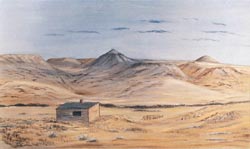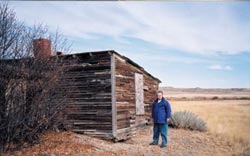Land of Legends: Will James, Pinnacle Bob & Sitting Bull
 The morning sun rises like a flaming disk and the Grassland horizon shimmers and dances in a sweeping arc. For a moment your heart rushes as sunlight roars westward, chasing the shadows from the coulees and river bottoms. This is dawn on The Grasslands, the great mixed-grass prairie of south-western Saskatchewan. For thousands of years this vision awakened buffalo hunters, ranchers, cowboys and homesteaders.
The morning sun rises like a flaming disk and the Grassland horizon shimmers and dances in a sweeping arc. For a moment your heart rushes as sunlight roars westward, chasing the shadows from the coulees and river bottoms. This is dawn on The Grasslands, the great mixed-grass prairie of south-western Saskatchewan. For thousands of years this vision awakened buffalo hunters, ranchers, cowboys and homesteaders.
 The Grasslands is a land of legends: the Plains Indian Horse Culture; the 6,000 square mile 76 Ranch; ‘Pinnacle Bob’, ‘The Mustang Wranglers’; and one of the west’s most celebrated artists, writers, horsemen, and movie stars – Will James.
The Grasslands is a land of legends: the Plains Indian Horse Culture; the 6,000 square mile 76 Ranch; ‘Pinnacle Bob’, ‘The Mustang Wranglers’; and one of the west’s most celebrated artists, writers, horsemen, and movie stars – Will James.
A small portion of this once expansive native prairie, and all its natural and historical treasures, is preserved today in the Grasslands National Park, in south-western Saskatchewan, near the Montana border. “There is a close connection between ranching and the preservation of The Grasslands in the Park,” says Colin Schmidt, the Park’s Client Services Supervisor. “If the ranchers of the past hadn’t avoided the use of the plough, there wouldn’t be a Grasslands for us to enjoy today.
“The Park,” he adds, “provides a special place where Canadians and visitors can have their own special connection with native prairie.”
 The closest community to the Park is Val Marie, a picturesque village on the Frenchman River, and known as “The Gateway” to the Grasslands National Park. Horses are one of the few permitted means of travel in the Park, and the Village of Val Marie has obligingly installed hitching rails on its streets. Val Marie is also the home of former rancher, Lise Perrault. Lise and Ferdinand Perrault ran the ‘Rocking 4’, 24 miles east of Val Marie, for 38 years and raised nine children. In 1984, they sold their ranch as a cornerstone of what was to be the 900 square kilometre Grasslands National Park. Today, Lise is one of the Park’s strongest advocates. “Our hills are beautiful,” Lise says. “There is colour in our country. It is for discerning people who have time to stop and look.”
The closest community to the Park is Val Marie, a picturesque village on the Frenchman River, and known as “The Gateway” to the Grasslands National Park. Horses are one of the few permitted means of travel in the Park, and the Village of Val Marie has obligingly installed hitching rails on its streets. Val Marie is also the home of former rancher, Lise Perrault. Lise and Ferdinand Perrault ran the ‘Rocking 4’, 24 miles east of Val Marie, for 38 years and raised nine children. In 1984, they sold their ranch as a cornerstone of what was to be the 900 square kilometre Grasslands National Park. Today, Lise is one of the Park’s strongest advocates. “Our hills are beautiful,” Lise says. “There is colour in our country. It is for discerning people who have time to stop and look.”
In her house, known as The Perrault Museum, she has entire rooms devoted to her historically accurate oil paintings, and her passion for the Park and its history – which includes NHL star Bryan Trottier, up-and-coming bull rider Karson LeGault, and Will James, the cowboy writer, actor and source of cow-punchin’ dreams for a generation of boys and girls.
When James homesteaded in Saskatchewan, about 1907, it was the time of The Grasslands transition from ranching to homesteading. The big ranches, such as the 76, and many others including the Turkey Track and the Matador, lost most of their herds in the devastating winter of 1906-07, opening the way for the homesteaders. Before the end of his glorious and tragic life, Will James would have written 24 books and become a household name across North America. His most famous book, Smoky, described the close relationship between a cowboy and his horse.
Today, Lise Perrault owns the definitive collection of Will James memorabilia and she allows the collection to travel to local museums for display. “We have one of the greatest stories right here in Val Marie,” she says, “but instead of preserving his homestead and making a display of it, we’re not taking advantage of it. Places in the United States promote Will James, and they don’t have anything like we have!”
 Lise’s interest in Bryan Trottier is two-fold; first, as a hockey player who grew up in the area, and second, as the descendent of the Trottiers who settled near Val Marie three generations earlier. Max Trottier
Lise’s interest in Bryan Trottier is two-fold; first, as a hockey player who grew up in the area, and second, as the descendent of the Trottiers who settled near Val Marie three generations earlier. Max Trottier
participated in the last buffalo hunt, in 1885, in which 482 buffalo were killed by ten riders and 50 men on foot just southwest of Val Marie. The Park hopes, by 2005, to re-introduce buffalo to the Grasslands.
Although the Park offers visitors official self-tour maps of the landmarks, the best way to see everything is alongside Lise Perrault. With astounding agility Lise leads the way up a hill and begins pointing to half-buried rocks. “That’s a tipi ring,” she says. “This is probably where they camped to watch for buffalo herds and for enemies.” The tribes that hunted in the area were primarily the Assiniboin, Cree and Blackfoot. Minutes later, Lise points out another site; the wagon trail the Northwest Mounted Police followed through the Grasslands as they travelled between their posts at Wood Mountain and the Cypress Hills. Wood Mountain is where Sitting Bull camped in the 1870’s after his battle at Little Big Horn.
 Besides the traditional stories of Indians, ranchers and homesteaders, Lise also knows the less-glamorous stories of the bootleggers who sold whiskey during the prohibition era. “That’s where Pinnacle Bob sold booze,” she says pointing to a far-off, eroded hill. “He had a hole dug in the ground and that’s where he kept it. He could always see if anybody was coming close.”
Besides the traditional stories of Indians, ranchers and homesteaders, Lise also knows the less-glamorous stories of the bootleggers who sold whiskey during the prohibition era. “That’s where Pinnacle Bob sold booze,” she says pointing to a far-off, eroded hill. “He had a hole dug in the ground and that’s where he kept it. He could always see if anybody was coming close.”
Another legend of Val Marie is the ‘Mustang Wranglers’ – five cowboys who left in the 1930’s. When drought and Depression took over their land, these tough cowboys, one as young as 15, drove a herd of horses 1,400 miles to British Columbia, where they started a horse ranch.
So, if you’re interested in seeing a land where sunburnt cowboys, Mounties, and homesteaders once rode the same trails as their Native predecessors, go to the Grasslands. It’s a vision you won’t forget – ever.














